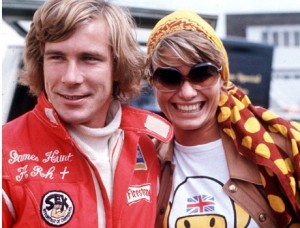The Real Story: “Rush” and the Formula One Rivalry Between Hunt and Lauda
Posted on September 27, 2013 at 3:59 pm
“Rush,” directed by Ron Howard and written by Peter Morgan, is the story of the rivalry between 1970’s Formula One drivers James Hunt and Niki Lauda. Much of it is true, including many of the statements made by the characters and the outcomes of the races, but this is not a documentary. There is some dramatic license to convey in two hours the events of several years. (SPOILER ALERT: Don’t read further if you have not seen the movie.) For example, the real life vote about whether to proceed with the race in the rain was not overwhelmingly in favor of proceeding. It was won by a single vote.
James Hunt‘s official Formula One Hall of Fame page describes him: “As a colourful personality and unconventional character he had no peers – alternately entertaining admirers and offending critics with his often outrageous behaviour…James worked at odd jobs, bought a wrecked Mini and spent two years race-preparing it, only to have his first entry fail scrutineering because the driver’s seat was an old lawn chair. Many of his early races ended in huge accidents. In one of them his Formula Ford crashed and sank in the middle of a lake. He might have drowned had he been wearing the requisite seatbelts he couldn’t afford to buy.”
As shown in the film, he did originally get his funding from Lord Hesketh, who ran out of money when he could not secure a sponsor after moving Hunt from Formula Three to the more expensive Formula One. Hesketh’s group was known for its champagne before races and putting the crew up in luxury hotels. James Hunt did marry the model Suzy Hunt and she did leave him for Richard Burton. Suzy Hunt married Burton after his second divorce from Elizabeth Taylor. Burton paid the $1 million divorce settlement that would otherwise have been James Hunt’s responsibility. Hunt became a racing commentator and died at age 42.
 Niki Lauda is serious-minded Austrian who was Formula One champion three times. His Formula One Hall of Fame page describes his accident: “In hospital, with first to third degree burns on his head and wrists, several broken bones and lungs scorched from inhaling toxic fumes, Niki Lauda was given up for dead and administered the last rites by a priest. Six weeks later, with blood seeping from the bandages on his head, he finished fourth in the Italian Grand Prix. Astonished doctors said he had recovered by sheer force of will. Jackie Stewart said it was the most courageous comeback in the history of sport. Niki said the loss of half an ear made it easier to use the telephone. In consideration of those who found his facial disfigurement unsightly he thereafter wore a red baseball cap, hiring it out to a sponsor for a hefty fee.”
Niki Lauda is serious-minded Austrian who was Formula One champion three times. His Formula One Hall of Fame page describes his accident: “In hospital, with first to third degree burns on his head and wrists, several broken bones and lungs scorched from inhaling toxic fumes, Niki Lauda was given up for dead and administered the last rites by a priest. Six weeks later, with blood seeping from the bandages on his head, he finished fourth in the Italian Grand Prix. Astonished doctors said he had recovered by sheer force of will. Jackie Stewart said it was the most courageous comeback in the history of sport. Niki said the loss of half an ear made it easier to use the telephone. In consideration of those who found his facial disfigurement unsightly he thereafter wore a red baseball cap, hiring it out to a sponsor for a hefty fee.”
The rivalry was real. But there was friendship there, too. The men actually even roomed together for a while. And when Hunt died, Lauda said, “For me, James was the most charismatic personality who’s ever been in Formula One.”




